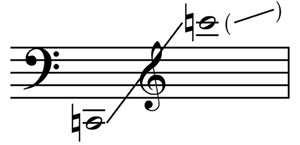
The range of the French horn is one of the instrument’s most distinctive and versatile qualities. The French horn is capable of producing a wide range of notes, from deep and sonorous tones in the lower register to bright and soaring melodies in the upper register.
Today, music for the horn is written in F and sounds a perfect fifth lower than written. The limitations on the range of the instrument vary according to the available valve combinations for the first four octaves of the overtone series and after that by the ability of the player to control the pitch through both their air supply and embouchure. The typical written ranges for the horn start at either the F♯ immediately below the bass clef or the C an octave below middle A.
French Horn Standard Range and Beyond
The standard range starts from a low F♯ and is based on the characteristics of the single horn in F. However, there is a great deal of music written beyond this range on the assumption that players are using a double horn in F/B♭. Its valve combinations allow for the production of every chromatic tone from two octaves on either side of the horn’s written middle C (sounding F immediately below the bass clef to F at the top of the treble clef).
Although the upper range of the horn repertoire rarely exceeds high C (two octaves above the horn’s middle C, sounding F at the top of the treble clef), skilled players in a good symphony orchestra can achieve even higher pitches.
It was once the case that notes written in the bass clef were written a fourth lower than the required pitch instead of a fifth but this is no longer the case.
Middle Range Example
In its middle range (the most comfortable), the French horn is capable of a great deal of expression, especially when playing a simple, melodic passage. Probably one of the best ever examples of this would be the andante of Tchaikovsky’s 5th Symphony.
Here is the wonderful horn solo from that symphony, played by Lars Michael Stransky with the Wiener Philharmoniker conducted by Riccardo Muti.
Pushing The Boundaries Of The Range
Some contemporary hornists enjoy pushing the expressive boundaries of the French horn’s range – and to great effect. Giovanni Hoffer is a good example. We first came across this talented musician when doing an interview about his passion for the Wagner tuba back in 2020 (full article here).
Here is Giovanni Hoffer on solo French horn playing with the Teatro Comunale Bologna Brass Band in an incredible performance of the iconic blues piece ‘Red House’ by Jimi Hendrix.
How The Range Is Affected By Skill Level & Instrument Quality
In addition to the physical limitations of the instrument itself, the range of the French horn can also be influenced by factors such as the player’s skill level, the quality of the instrument and the context of the music. Skilled players are often able to produce a wider range of notes and manipulate the sound of the instrument in order to create a greater variety of tones and colours. High-quality instruments with well-crafted valves and tubing can also produce a clearer and more resonant sound across the full range of the instrument.
Summary
The French horn’s range is a key aspect of the instrument’s appeal, versatility and expressive power. With a range that spans four octaves, the French horn can produce such a wide variety of tones and colours that it can be played in many musical genres. Through the use of different fingerings, techniques and mutes, skilled horn players are able to push the limits of the instrument’s range. All this combined makes the instrument one of the most unique and appealing of all brass instruments.